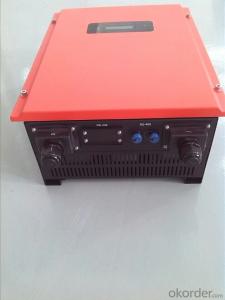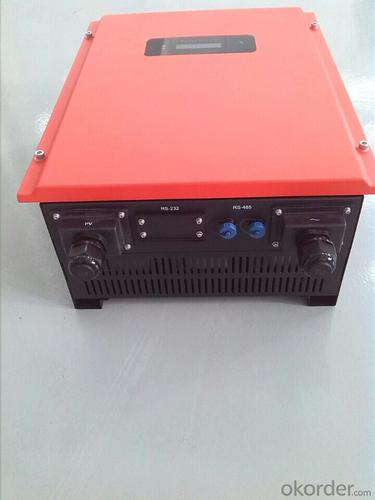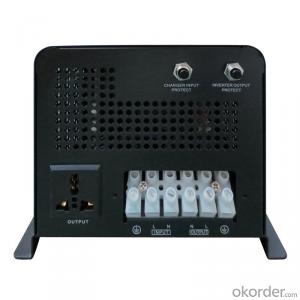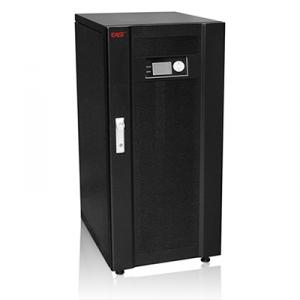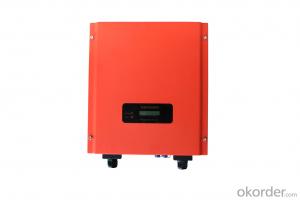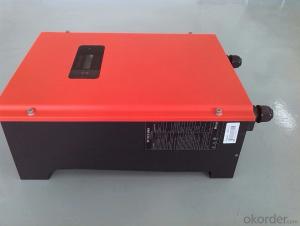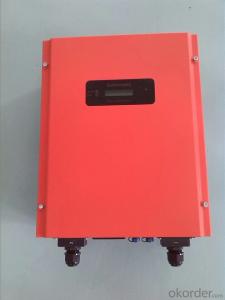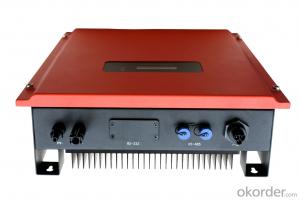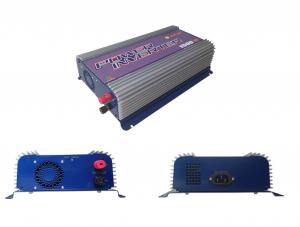Grid Tie Solar Inverter Sunteams 1500-3000(US)
- Loading Port:
- China Main Port
- Payment Terms:
- TT OR LC
- Min Order Qty:
- -
- Supply Capability:
- -
OKorder Service Pledge
Quality Product, Order Online Tracking, Timely Delivery
OKorder Financial Service
Credit Rating, Credit Services, Credit Purchasing
You Might Also Like
The Sunteams 1500 ~5000 series is applicable to various rooftops and small scale photovoltaic grid-connected power plants. Their nominal output powers are 1.5 kW, 2 kW, 2.5 kW,
3 kW, 3.6 kW, 4 kW and 5kW respectively.
This series is transformerless and has a wide range of MPPT input voltage. Its maximum conversion efficiency and MPPT tracking accuracy reach 97.6 % and 99.5 % respectively. The maximum DC voltage reaches 550 V. Its multilingual LCD display facilitates easy operation. It has waterproof direct plug-in terminals. It has overvoltage, islanding, short-circuit, overloading and overheating protection functions. Its IP65 protection degree will ensure it runs well in various tough environments.
These units are available with or without wirebox.
UL certified
■ For countries with UL certification (UL 1741 / IEEE 1547)
■ For countries with UL certification (UL 1741 / IEEE 1547)
Efficient
■ The CEC efficiency of the inverter can reach 95.0 %-97.5 %
■ Transformerless desi
■ The CEC efficiency of the inverter can reach 95.0 %-97.5 %
■ Transformerless desi
Simple
■ ‘Plug and play’connection for easy installation and maintenance
■ Designed for hanging with simple and easy installation
■ Fanless cooling concept
■ ‘Plug and play’connection for easy installation and maintenance
■ Designed for hanging with simple and easy installation
■ Fanless cooling concept
Communicative
■ RS232/RS485 interfaces as standard
■ Optional Bluetooth technology
■ RS232/RS485 interfaces as standard
■ Optional Bluetooth technology
- Q: How do you connect a solar inverter to a data monitoring system?
- To connect a solar inverter to a data monitoring system, you typically need to connect the inverter to a communication gateway or data logger. This can be done through wired connections such as Ethernet or RS485, or wirelessly using Wi-Fi or cellular networks. The data monitoring system will then collect and analyze the data from the inverter, providing real-time monitoring and reporting on the solar power generation and system performance.
- Q: Can a solar inverter be used in areas with high humidity and salt air exposure?
- Certainly, a solar inverter can indeed be utilized in regions characterized by elevated humidity levels and salt air exposure. Nevertheless, it is imperative to opt for a solar inverter explicitly engineered to withstand such circumstances. The presence of high humidity has the potential to induce corrosion and harm electronic components, while salt air exposure can expedite corrosion due to the corrosive properties of salt. Consequently, it is vital to choose an inverter constructed from corrosion-resistant materials, such as stainless steel or coated circuit boards. Furthermore, consistent maintenance and cleaning of the inverter are essential to guarantee optimal performance and longevity in such environments.
- Q: Can a solar inverter be used with different solar panel types?
- Yes, a solar inverter can be used with different types of solar panels. Solar inverters are designed to convert the direct current (DC) generated by solar panels into alternating current (AC) that can be used to power household appliances and feed into the electrical grid. As long as the solar panels produce compatible DC voltage and current levels, they can be connected to the solar inverter. Different solar panel types, such as monocrystalline, polycrystalline, and thin-film, may have varying electrical characteristics, but modern solar inverters are typically equipped with advanced electronics that can adapt to these differences. However, it is important to ensure that the solar inverter is properly matched with the solar panel specifications to ensure optimal performance and efficiency.
- Q: What is the role of a frequency regulation feature in a solar inverter?
- The role of a frequency regulation feature in a solar inverter is to maintain a stable and consistent frequency of the electrical output, ensuring compatibility with the grid or connected appliances. This feature helps to mitigate fluctuations in frequency caused by varying solar irradiance or load fluctuations, thereby improving the overall efficiency and reliability of the solar power system.
- Q: Can a solar inverter be used with different grid voltages or frequencies?
- No, a solar inverter cannot be used with different grid voltages or frequencies. Solar inverters are designed to convert the DC power generated by solar panels into AC power that matches the specific voltage and frequency of the local electrical grid. Using a solar inverter with different grid voltages or frequencies can lead to compatibility issues and may result in inefficient or malfunctioning operation of the system.
- Q: What is the role of voltage regulation in a solar inverter?
- The role of voltage regulation in a solar inverter is to ensure that the voltage output from the solar panels is converted and maintained at a stable and appropriate level for efficient and safe operation of electrical devices or for grid connection. This regulation helps to optimize the performance of the solar inverter and prevents voltage fluctuations that could potentially damage or disrupt the functioning of connected equipment.
- Q: How does a solar inverter handle variations in solar panel cleanliness?
- A solar inverter is not directly responsible for handling variations in solar panel cleanliness. However, a clean solar panel allows for maximum absorption of sunlight, resulting in optimal energy production. If solar panels are dirty, the amount of sunlight absorbed decreases, leading to reduced energy generation. It is the responsibility of the solar panel owner to regularly clean and maintain the panels to ensure their efficiency.
- Q: How does a solar inverter impact the overall system reliability?
- A solar inverter plays a crucial role in the overall system reliability as it converts the direct current (DC) generated by solar panels into alternating current (AC) that can be used to power household appliances or be fed into the grid. It ensures the reliable and efficient functioning of the entire solar power system by optimizing power output, managing voltage levels, and protecting against various electrical faults. A high-quality solar inverter enhances system performance, improves energy yield, and minimizes downtime, ultimately increasing the overall reliability of the solar power system.
- Q: Can a solar inverter be used with a solar-powered water desalination system?
- Yes, a solar inverter can be used with a solar-powered water desalination system. A solar inverter is responsible for converting the direct current (DC) power generated by solar panels into alternating current (AC) power, which is required to operate most electrical appliances and systems. In the case of a solar-powered water desalination system, the solar inverter can be used to convert the DC power generated by solar panels into AC power to run the various components of the desalination system, such as pumps, motors, and control systems.
- Q: Generally a large grid-connected photovoltaic power plant will have several inverters
- The use of a high-power grid-connected inverter into the grid, the need for line design is relatively simple, because the DC and AC lines are separated, the use of convergence box to summarize, DC bus and then into the grid inverter
Send your message to us
Grid Tie Solar Inverter Sunteams 1500-3000(US)
- Loading Port:
- China Main Port
- Payment Terms:
- TT OR LC
- Min Order Qty:
- -
- Supply Capability:
- -
OKorder Service Pledge
Quality Product, Order Online Tracking, Timely Delivery
OKorder Financial Service
Credit Rating, Credit Services, Credit Purchasing
Similar products
Hot products
Hot Searches
Related keywords
